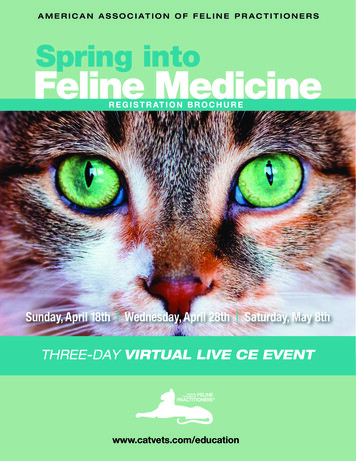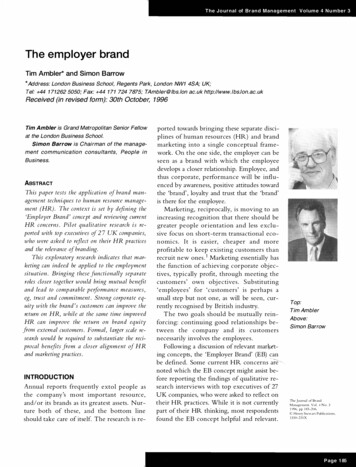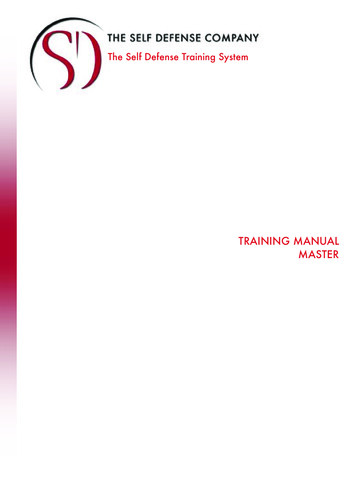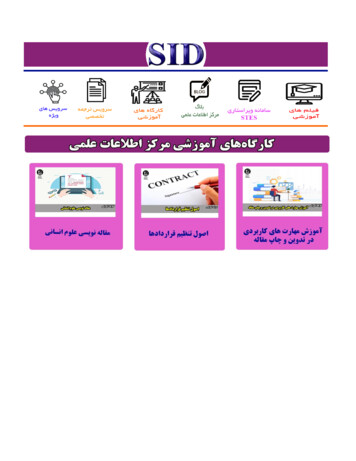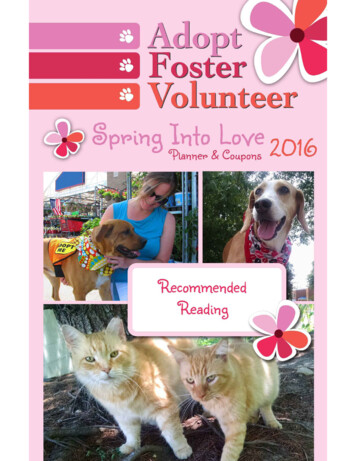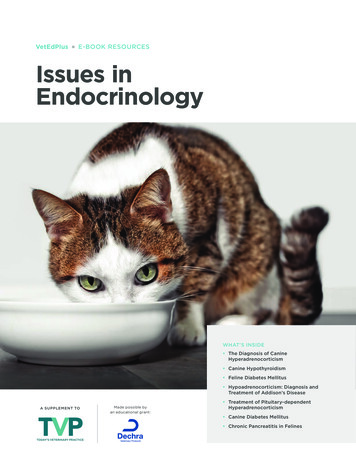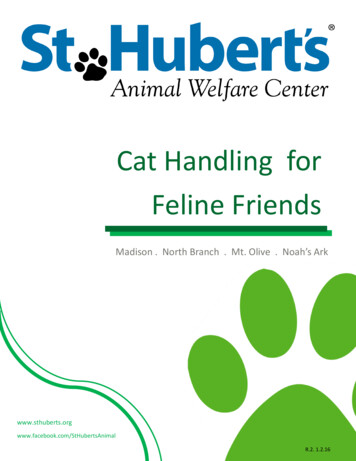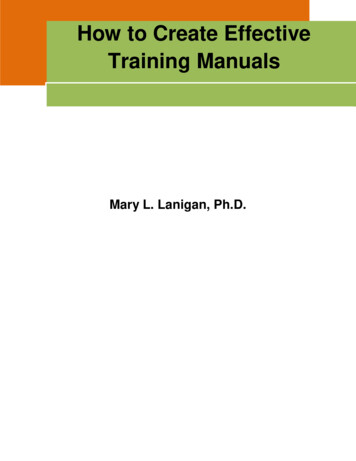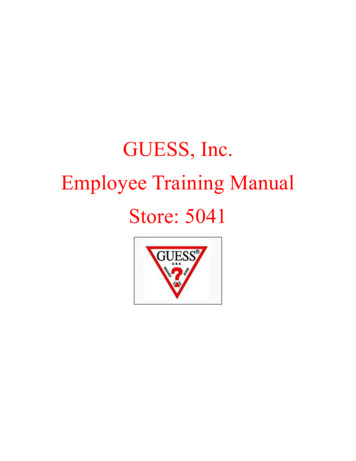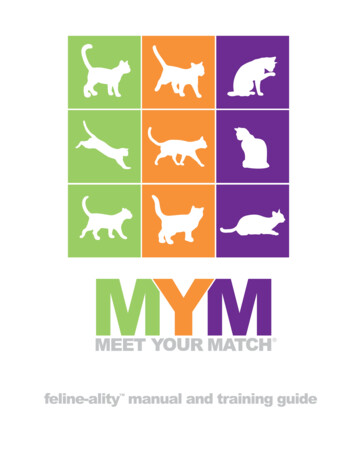
Transcription
feline-ality manual and training guide
meet the feline-alitiesI N D E P E N D E N T - G R E G A R I O U 17181920212223242526272829300low valiance1234568910privateinvestigatorsecret admirerlove bugthe executivesidekickpersonal assistantMVPparty animalleader of the bandmedium valiance11121314151617181920212223high valianceV A L I A N C E724252627282930313233343536373839404142433132
thanks to you!On behalf of all shelter cats throughout the nation and their soon-to-be Meet Your Match adopters, the ASPCA is grateful beyond words to the following organizations for openingtheir shelters to us. The Meet Your Match Feline-ality Adoption Program is the result ofcountless hours of data collection, beta testing, amazing insights, observations, and creativeinput these agencies provided. Without these organizations, and the people within them, thisprogram would still be a dream instead of a reality.phase I – cats with guardiansChisholm Creek Kennels, Wichita, KSChisholm Trail Animal Hospital, Wichita, KSCountryside Veterinary Clinic, Wichita, KSHeartland Animal Hospital, Wichita, KSIndian Hills Animal Clinic, Wichita, KSOakcrest Pet Hospital, Wichita, KSSkaer Veterinary Clinic, Wichita, KSphase II – shelter catsAnimal Refuge League of Greater Portland, Westbrook, MEWisconsin Humane Society, Milwaukee, WIHamilton-Burlington SPCA, Hamilton, ON Canadaphase III – matching cats to adoptersAnimal Refuge League of Greater Portland, Westbrook, MEKansas Humane Society of Wichita, Wichita, KSHumane Society of Boulder Valley, Boulder, COAnimal Welfare Association, Voorhees, NJHamilton-Burlington SPCA, Hamilton, ON, Canadaphase IV – modified assessmentto fast track cats to adoptionHumane Society of Boulder Valley, Boulder, CO
copyright 2013 The American Society for the Prevention of Cruelty to Animals . Reprinted with permission of the ASPCA .The ASPCA has made additional resources for the Meet Your Match program available to help you implement andbe successful. Visit www.ASPCApro.org where you will find FAQs, images and logos for download, Flash movie to promoteMYM on your website, tools and tips for generating public awareness, and Brand Standard Toolbook.
contentsresearch41feline-ality in action13requirements and equipment55body posture17the feline-ality assessment59glossary31selecting a feline-ality 63trademarks35the adopter survey5
cats, catsand more cats!In the United States, the number of companion cats is now significantly higher than dogs.More households than ever before own at least one cat, and the number of people who ownmore than one cat has greatly increased as well. While the popularity of feline companions isrising, supply still exceeds demand and animal shelters are bursting at the seams with morecats and kittens than they can adopt out. And, although there are twice as many cats as dogsin many shelters, cats are half as likely to get adopted.Why bring feline-ality to your shelter?Despite shelters’ efforts, the sobering reality is that the public is more likely to bring a straycat into their home than to adopt from a shelter. Thirty-four percent of cat guardians reportacquiring their feline companion as a stray, compared to 16 percent who report adoptingtheir cat from a shelter.The Meet Your Match Feline-ality Adoption Program increases opportunities for shelter catsto find loving homes by: allowing your shelter to customize and create lasting matches between adoptersand cats helping your shelter to better market adult cats increasing your shelter’s cat adoptions and reducing returns improving your customer service positioning your shelter to provide customized matching that new pet owners can’tget anywhere else most importantly, increasing the likelihood that adopters will bond with their cats andtruly bring them into their families4title here
theresearchResearch and development of Feline-ality was conducted by Emily Weiss, Ph.D.,CAAB, ASPCA Vice President of Shelter Research and Development.The ASPCA owns all intellectual property in the Meet Your Match program, includingtrademark and copyright rights. Please contact the ASPCA if you would like to purchaseor license any of the Meet Your Match materials.research 5
developing the researchPrior to Feline-ality , little research had been done on feline behavior assessment tools andtheir validity. Several animal behavior experts (Katherine Houpt, Ilana Reisner, Kathy Carlsteadand others) have been doing fantastic work regarding modifying behavior, but there has beenconsiderably less focus on the predictability of behaviors.Just a few months before the Feline-ality research project was to begin, Janice M. Siegford et alpublished an exciting study regarding the validity of an assessment tool for cats. The paper validatedcomponents of a tool developed in the 1980’s to assess the suitability of cats for placement innursing homes.Siegford’s work became an important component to Feline-ality . We then surveyed many sheltersacross the country regarding behavior assessments they were currently using for their cats. None ofthe facilities we communicated with had conducted formal research, but several had assessmentsthey felt were helpful in deciding adoptability or future behavior. Many of the items were consistentfrom shelter to shelter, including behavior in the cage and ease of handling. We chose to investigateseveral of these items.phase I: cats with guardiansThe first piece of research focused on determining if wecould accurately predict how a cat was likely to behave inthe home based on his responses to assessment items.Our focus was whether or not there were correlationsbetween behavior in the assessment situation and guardianreports. To facilitate this, we chose to use a population ofcats with established guardians.We identified seven cat boarding facilities in Wichita,Kansas, willing to participate in the study. Guardians wereasked to participate when they made the appointment toboard or dropped their cats off. Cats between nine monthsand 13 years of age were the focus of the study. A totalof 56 cats were assessed, but six were dropped from thestudy because of incomplete guardian surveys.swatThis distance-enhancing behaviorinvolves the cat striking out towardthe offending stimuli with one or bothof his front paws.novel roomA room that is new to the cat.blind to survey resultsStudy participants are kept unawareof purpose of the assessment and/orother information in order to keepthem unbiased. Evaluators or subjectsthat purposely have no knowledgeregarding the results of a portion of thestudy, so as not to skew the final results.socialThis phase gave us the opportunity to investigate one itemA cat that is interactive with the evaluregarding aggression. Since these cats were from homes,ator in an affiliative manner.we could verify whether or not the aggression we observedduring assessment at the boarding facilities was also foundin the home. Seven cats displayed aggression, either byattempting to bite or swat at the evaluator during either the cage or novel room components of theassessment. Six of those seven cats had no reports of aggression in the home environment. Yet allsix cats were reported by their guardians to always run away when guests visited or new situationsarose. This area will be investigated in the future.Another interesting piece of information acquired during this phase of the work focused on litter boxuse. In our study, there was no correlation found between litter box use/non-use in the boardingenvironment, and litter box use/non-use in the home. We did, however, find a correlation between6researchtitlehere
cats that did not scatter their litter at all,and litter box problems in the home. We willbe investigating this further in the future aswell. The information gathered from the datacard and assessment was compared to theguardian report. We found correlationsbetween behavior in the assessmentenvironment and home report regarding:affection, social interaction, reaction to novelstimuli, interaction with toys, and behaviorwith children and others.Modifications to both the assessment and thedata card were made based on the results ofthis initial study and we readied ourselves forPhase II – Shelter Cats – involving testing ofthe refined tool in a shelter environment.phase I: cats with guardians Cage behavior data collected for threeto six days after arrival A ssessments conducted approximately72 hours after cats entered the facilities Survey for guardians regarding their cat’sbehavior in the home Evaluators who were blind to thesurvey resultsphase II: shelter catsOnce the assessment was pared down, wewanted to assess the efficacy of the tool ina shelter environment. There are many morevariables in a shelter environment than in aboarding environment, not least of all strays.Animal Refuge League of Greater Portlandin Westbrook, Maine, and the WisconsinHumane Society in Milwaukee agreed toserve as research sites.We were able to collect complete data for 84cats. The cats’ behaviors both in the cage andduring the assessment were compared to newadopter reports. Behavior in the cage did notcorrelate with the adopter report as strongly asmany of the out-of-cage items. In fact, manyitems on the data card did not correlate withthe guardian report much at all. We took acloser look at the data card information, andfound that behavior information collected duringjust the first 36 hours did in fact correlate withbehavior in the home.In phase II, each shelter wasasked to follow a protocol: Data on cage behavior was collected for atleast three days T he assessment was conducted betweenday three and day six A ssessments were not shared withadoption staff to assure that adopterswould not know how the cat behavedduring the assessment Once assessed, the cats were spayed orneutered and made available for adoption A phone survey was conducted with newadopters three weeks post-adoptionJust as Siegford et al (2003) found with their research, we found that many behaviors seemed stablewhen the cat was moved from one environment (the shelter) to a new environment (the home). Forexample, cats that vocalized during certain assessment items were likely to be “talkative” cats in thehome. Cats that played with toys in the assessment were likely to play with toys in the home. Cats thatbehaved by withdrawing from novel stimuli during the assessment process were likely to withdraw fromnovel stimuli in the home. Further, we found certain aspects of social interaction with the evaluatorwere also found in the home by the new adopter.researchtitlehere 7
Feline-ality was coming together. We needed to beable to color code our cats so that the process fit theMeet Your Match process. We found two major scales:an independent-gregarious scale that measuredsocial behavior and a valiance scale which measuredresponse to novel stimuli (how the cat was likely toreact in new situations). We also identified impor tantbehaviors that were stable, but did not fit into thosetwo scales. For example, knowing whether or not acat was vocal or playful could enhance bonding withthe new pet.valianceRefers to the cat’s response to novel stimuli. A highvaliant cat is likely to approach new stimuli, while alow valiant cat is likely to retreat from novel stimuli.independentThe low end of the independent-gregariousscale, meaning the cat does not often seeksocial interaction.gregariousThe high end of the independent-gregarious scale,meaning the cat is very social and interactive.phase III: matchingcats with adoptersNow that we had a tool to assess certain feline behaviors, we needed to test several other components: C ould we interact with the adopter in a fun and meaningful way to helpguide and educate them to make a good match? I s the process ‘do-able’ for shelters? Can they make the time? Understandthe components? Find the space? A re the expectations that the adopter develops during the adoption processones that they actually experience once the cat is in the home? Do the adopters like the process? Would the adopters come back to a Meet Your Match shelter?We first needed to develop the AdopterSurvey to identify expectations and lifestylein order to make the best match. Whencompleted, we invited five shelters to helpbeta test the program (Animal Refuge League,Westbrook, Maine; Kansas Humane Society,Wichita, Kansas; Humane Society of BoulderValley, Boulder, Colorado; Animal WelfareAssociation, Voorhees, New Jersey; andHamilton-Burlington SPCA, Hamilton, Ontario,Canada). Three shelters tested the programfirst. We measured their experiences andthose of their adopters, and then broughtin two additional shelters after we mademodifications to the process.phase III procedure A ll cats were assessed and givena color-coded cage card based onthe assessment score Cats were spayed/neutered and madeavailable for adoption Once adopted and in the home for threeweeks, an ASPCA representative calledthe adopter and conducted a surveyregarding both the adoption experienceand the behavior of the cat A n outside agency conducted interviewswith the shelter staff regarding all aspectsof their experience with the program8research
the adopter experienceThe Adopter Survey included several questions focusing onthe adoption experience.105 out of 107 reported that they would probably choosea shelter that uses the Meet Your Match Adoption programwhen adopting an animal in the future.When asked “How did your adoption experience impact youropinion of the shelter? Please rate on a scale of 1 to 10 with10 being ‘very positive’, 5 being ‘no impact on your opinion’,and 1 being ‘very negative’”, the mean response was 9.13.Only one adopter rated it under 5 and the vast majority (88)rated the impact on their opinion of the shelter between 8-10.When asked to rate how satisfied they were with theMeet Your Match Adoption Program, the average responsewas 8.89 out of 10. When asked to rate how well the cat theyadopted exhibits the type of personality that they expectedafter participating in the Meet Your Match adoption program,the average response was 9.03! This is exciting because weknow people adopt out of their color category (60 adoptersadopted within their color and 47 outside their color), and theMeet Your Match tools helped them go home with the rightexpectations to make a good match regardless.Nearly all of theadopters surveyedsaid they wouldprobably select ashelter that usedthe Meet YourMatch AdoptionProgram whenadopting an animalin the future.adopters told us“Excellent program When I went [to ARL] therewere several cats available and the programhelped me decide who was right for me. I couldsee how the cat would behave after I got herhome. She acts exactly as they said she would.”— KW adopted Annabelle from ARL“He is not a perfect fit for our family, we shouldhave chosen a cat in our orange category, but thekids fell in love with a purple cat he is shy andkind of standoffish but we love him and willmake it work.”— SD adopted Blackie from HSBV; orange people –adopted a purple catresearch 9
stability of behaviorThe overall social score was statistically significantwith adopter reports of: Cat spending time in same room as adopterResponse to pettingAffiliation with children“My cat is constantly finding new ways to get my attention”The social score became much more predictive when cats that scoredfour or lower were removed from analysis. In our sample of 107, thisresulted in six cats removed from analysis. We hypothesize that catsthat score this low are not behaving as they normally would – that theyare “shut down” and need a bit more time to settle before they areready for Feline-ality .The overall valiance score was statistically significant withadopter reports of: How quickly the cat was likely to adjust to the new home How the cat was likely to react to guests in the home Comfort with handling for routine health issuesAs with the earlier research, we found that certain behaviors were quitestable, such as vocal behavior, toy use, and comfort with being held.shelter statisticsFeline-ality predictsreaction to guests,vocal behavior,response to children,comfort with handlingand more!Once the testing was completed, the beta test shelters were asked to compare their numbers regardingeuthanasia, length of stay, adoptions and returns for the period they instituted the Feline-ality program,and the same time period the previous year. The following is just a taste of the results.The Animal Refuge League reduced euthanasia by more than 45 percentand reduced the average length of stay by 20 days.The Kansas Humane Society saw a sharp reduction in return rates —more than 11 percent — and experienced a 46 percent increasein adoptions.The Humane Society of Boulder Valley had an average reduction of sevendays in length of stay.The percentage of cats adopted compared to intake was up 20 percentfor the Animal Welfare Association while the average reduction in lengthof stay was 23 days.Hamilton-Burlington saw a three percent decrease in both euthanasiaand returns.10research
shelter experienceSince we were developing a program to be implemented by shelters across the country with varying protocolsand resources, we felt it was also important to measure the experience for the employees at the five betatesting sites. In order to assure accurate reporting, interviews were conducted by an impartial third partyuninvolved in the Meet Your Match Adoption Program. All five operations managers at the beta testing siteswere very positive about the overall program and the manageability of it. In fact, shelter personnel fromexecutive directors through kennel staff were enthusiastic about the Meet Your Match Feline-ality program.Adoption counselors especially noted that the process improved the communications with adopters, helpingnew guardians better understand the animals and creating a cooperative rather than an adversarial process.The result is more successful placement of cats in homes.The following are some of the quotes collected from the staff at our beta test facilities:“As I’m becoming more comfortable with [the program], it has been a lot of fun. Calling it a survey instead of an applicationputs people immediately at ease. Then we walk the adopters over to the board to figure out what color they are and lookat what areas would be good for them. They’re really excited to see which cats will match. It’s more involved, more fun,less rigid.”“[Adopters] select a cat and they say, ‘What paperwork do I need to do?’ And we say, ‘That’s it.’ We say the best matchfor you is the green kitty, and they read all about the green personality on the cards. Some of them have a really goodtime with it. I think it’s made a difference to the adopter and the shelter.”“I think [the Meet Your Match program] is really good. I think it’s helping matching cats to good homes. Before we hada lot of returns. Now they have a better idea of what the cat is all about.”“I love it! It has been an incredible amount of preparation work which has ultimately been a really great exercise for thestaff and volunteers and the beta testing has really forced them to look at some of their overall logistics.”“[The adoption process] runs much smoother than the way that we were handling things before. It frees us up to spendtime with the adopters and answer questions versus verifying information. It gives us more interaction with the adopter.”“A bit more work but it’s better for adoptions. We have to do more assessments but it’s better for adoptions — increasingthem. I think [cats] are getting adopted a little quicker because [adopters] feel they know about them.”“Our behavior and health team that conducts the Feline-ality Assessment now has a better sense of which cats willneed which forms of intervention that’s available from staff or volunteer resources to really showcase them to their best,i.e. cats that want to hide and perch versus those that thrive with play outside kennels. All felines had been getting thesame intervention and we can now separate them out. Cats will be less stressed and be more comfortable and hopefullythey will show better on the floor. For clients, it is a great opportunity. In July, 130-140 cats were available in Adoptions.We often heard, ’There are so many, where do I start?’ Feline-ality will help answer this question.”phase IV: modified assessmentto fast track cats to adoptionA published manuscript will fully outline and describe the research on the modified Feline-ality Assessment.research 11
When we began workon Feline-ality, we werehopeful we would beable to develop a toolto better match cats tothe right adopter.The final Feline-alityprogram has exceededour expectations.Adopters, shelter staffand cats are all richlybenefiting from theprogram.12research
requirementsand equipmentrequirements and equipment 13
what do you need?When cats enter the shelter they should each receive an exam and vaccinations at the time of intake.Once the intake exam is complete, cats should be placed in their holding cages and be allowed tosettle for at least 18 hours prior to assessment.During the acclimation period, we recommend spot cleaning while the cat remains in the cageunless the cage is quite dirty. This will lower the cat’s stress and thus, the probability of disease.Acclimation will take longer if they are removed daily for cleaning. Refrain from spaying/neuteringuntil after the cat has been assessed and a color-coded cage card has been assigned.storage for suppliesAs basic as it sounds, the most successful Meet Your Match facilities thought through the processof assessment to the point that all supplies were assigned specific storage spots and a specificperson was made responsible for the replenishing of supplies when needed. A large Tupperwaretub is ideal for storing assessment supplies in the assessment room.storing assessmentsThe Feline-ality Assessments will be used in the adoption process. It is important that theassessments are stored where the adoption counselors can easily access them while witha client. Be sure to identify this space before implementing, and determine how the paperworkwill move with the cat as he is made available for adoption.14requirements and equipment
assessment room(novel room)stopwatches (silent)chairThe ideal assessment room size is about10’x10’. There must not be any placeswhere the cat can hide (such as under,inside or behind counters, desks or otherlocations). It is important that the area isquiet and free of distractions. Noise canruin a cat’s assessment. A sound machine(sometimes called a sleep or white noisemachine) can be used to help decreaseoutside noise if necessary.One of these watches can be attached tothe clipboard, as it will be used to countdown from five minutes. The second watchwill be held by the evaluator. It’s importantthat both stopwatches be silent so youcan avoid distracting the cat during theassessment item.The chair should be plastic or metal so asnot to absorb odor. The chair must be ableto be disinfected.cat toyscat carrierclipboardA variety of clean cat toys should alwaysbe available. Make sure your assessmentkit has at least one each of the following:a toy mouse, cat charmer, feather wand,and a ball. Replace or wash toys eachweek depending on the number of catsassessed.The cat will need to be placed into astandard airline carrier for one of theitems. Be sure to disinfect the carrieras needed. Cats should be placed incarriers that are dry and have had achance to air after disinfection.Using a clipboard while conductingthe assessment helps to keep allthe paperwork in place.I’m an MVP.Hi! My name is .Do you seek affection? I do! If you also like petting, purrs,and paws kneading your lap, I think we might have a LOT incommon. I’m looking for “someone who enjoys quiet timesand togetherness.” Could that someone be you?cage cardThe colored cards are an important part of the process,and even when cats are in colony rooms, you will wantto display the cage cards. By affixing a small picture ofthe cat to its cage card, you will help adopters identify thecats within their color category — even when they are ina colony setting. COPYRIGHT 2008 THE ASPCA. ALL RIGHTS RESERVED. REPRINTED BY PERMISSION OF THE ASPCA. requirements and equipment 15
checklistassessment roomstopwatches (silent)chaircat toyscat carrierclipboardassessment formcage card16requirements and equipment
the feline-alityassessment the feline-ality assessment 17
the assessmentAll healthy cats that can be handled and are at leastnine months of age should be Feline-ality assessedafter at least 18 hours of entering the shelter. Ourrecent research found that the assessment can be justas or more predictive after a stay as short as 18 hours.Females in heat should not be assessed if it can beavoided. If you must assess them, please be awarethat the Feline-ality assessment will be less predictive.Another assessment should be done if the cat is stillin the shelter after she has come out of heat.The assessment consists of eleven items. After theitems have been administered their scores will determine their Feline-ality description.Items 1-4 will occur while the cat is still in his cage.novel roomItems 5 through 11 will take place in the Novel Room.The ideal space is 10 feet by 10 feet, but a somewhatsmaller or larger room will do. A room free of hiding spots is more important to the assessment processthan the square footage. The area outside the room during the assessment needs to be quiet and asdistraction-free as possible. Avoid areas where barking dogs, chirping birds, ringing phones, talking andhigh foot traffic will be audible.All items are performed by one staff member or volunteer and are designed to determine the cat’sindependent-gregarious scale and valiance.Before the assessment begins, place a chair, assortment of clean cat toys and two stopwatches in theNovel Room, so you are prepared to move immediately into items 5 through 11 when you have completedthe first four items. Then, wash your hands and take a clean plastic cat carrier (crate) and a clipboardwith assessment form attached into the area where the cats are housed for your first item.18the feline-ality assessment
item #1: body postureThe body posture assessment is designed to give us information about the cat’s social behavior.This assessment item is to be conducted in conjunction with item #2 Greeting Approach.Enter the score for item #1 and #2 after completion of the Greeting Approach.Take a quick mental snapshot as you approach the cage. You should not call out or coax thecat, but simply look toward the cat when approaching while carefully observing his body posture.item #1: body postureChoose one of the following responses:Soft and relaxedadd 1 ptTense body with twitching tailadd 1 ptFlattened body with dilated pupilssubtract 1 pttotal points for item #1other observations:item #2: greeting approachThe Greeting Approach determines sociabilitytoward strangers when the cat is in stressfulsurroundings. This item helps us determinesocial response (the independent-gregariousscale) and identifies cats that are likely to bevocal in the home.After taking a brief snapshot of the cat’s bodyposture during item #1, continue to approachthe front of the cat’s cage while speaking to thecat in a soft, normal tone of voice. Once in frontof the cage, observe the cat’s response to yourpresence through the closed cage door.!common errors:item #2Evaluator speaks too loudly,stares at the cat or otherwiseintimidates the cat with herbody posture.Evaluator allows othersto enter the room duringthe observation.Evaluator assesses too closeto feeding or cleaning time.title herethe feline-ality assessment 19
item #2: greeting approachChoose one of the following responses:At front of the cage, soliciting attention by rubbing, chirping, etc.This is a confident, high-status cat that is comfortable demanding physical contactfrom a stranger.add 3 ptsComes to front of cage after you encourageThis cat is a little less confident but does respond to human coaxing and seems tofind human interaction motivating.add 2 ptsDoes not approach but meows, chirps or blinksThis cat is social but not valiant enough to approach at this time.add 1 ptDoes not approachThis cat is displaying no motivation to interact with strangers yet is confident enoughnot to retreat.0 ptsAttempts to hideThis cat is fearful of strangers at the moment and looks to retreat to a safe place.subtract 1 ptHisses / growlsThis cat is performing a distance-enhancing behavior. As long as the evaluator heedsthe warning and doesn’t attempt to get closer, the cat’s behavior isn’t likely to escalate.subtract 2 ptsChargesThe cat is not motivated to interact with the evaluator in a positive manner at thistime and is attempting to drive off the evaluator. He is valiant enough to risk injury byreducing the distance between the evaluator and himself in order to do so.subtract 3 ptstotal points for item #2other observationsIf the cat displays other behaviors than those listed, use the Other Observations section to makenotes. These observations will be passed onto potential adopters by the shelter’s adoption counselorswhen they pull the cat’s Feline-ality Assessment and will help give a more complete picture of howthis cat will initially respond in his new home.rubA confident affiliative behavior in which the cat makescontact with an individual with the side or bottom ofhis head, often followed by leaning the rest of hisbody against the individual while moving forward.meowAn affiliative vocal behavior that sounds likeme-ow. Produced while mouth is open andthen gradually closed.chirpsAn affiliative vocal behavior that sounds likebrrrrt. Mouth is usually close
guide and educate them to make a good match? Is the process ‘do-able’ for shelters? Can they make the time? Understand the components? Find the space? Are the expectations that the adopter develops during the adoption process ones that they actually experience once th
